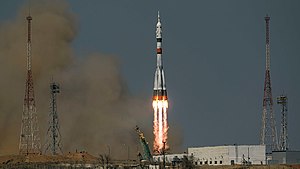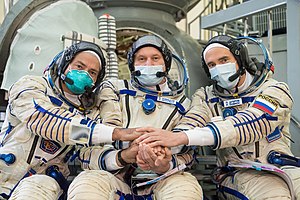Soyuz MS-18
 Y. A. Gagarin launches atop a Soyuz-2.1a | |
| Names | ISS 64S |
|---|---|
| Mission type | Crewed mission to ISS |
| Operator | Roscosmos |
| COSPAR ID | 2021-029A |
| SATCAT no. | 48159 |
| Website | https://www.roscosmos.ru/ |
| Mission duration | 190 days, 20 hours and 53 minutes |
| Spacecraft properties | |
| Spacecraft | Soyuz MS no. 748 Y. A. Gagarin [1][2] |
| Spacecraft type | Soyuz MS |
| Manufacturer | RSC Energia |
| Crew | |
| Crew size | 3 |
| Launching | |
| Landing | |
| Callsign | Kazbek [3] |
| Start of mission | |
| Launch date | 9 April 2021, 07:42:41 UTC[4][5][6] |
| Rocket | Soyuz-2.1a |
| Launch site | Baikonur Cosmodrome, Site 31 |
| Contractor | Progress Rocket Space Centre |
| End of mission | |
| Landing date | 17 October 2021, 04:35:44 UTC |
| Landing site | Kazakh Steppe, Kazakhstan |
| Orbital parameters | |
| Reference system | Geocentric orbit |
| Regime | Low Earth orbit |
| Inclination | 51.66° |
| Docking with ISS | |
| Docking port | Rassvet nadir |
| Docking date | 9 April 2021, 11:05 UTC [6][3] |
| Undocking date | 28 September 2021, 12:21 UTC |
| Time docked | 172 days, 1 hour and 16 minutes |
| Docking with ISS (Relocation) | |
| Docking port | Nauka nadir |
| Docking date | 28 September 2021, 13:04 UTC |
| Undocking date | 17 October 2021, 01:14:00 UTC |
| Time docked | 18 days, 12 hours and 10 minutes |
 Mark Vande Hei, Oleg Novitskiy and Petr Dubrov | |
Soyuz MS-18 (spacecraft named "Y. A. Gagarin") was a Soyuz spaceflight that was launched on 9 April 2021 at 07:42:41 UTC.[4][7] It transported three members of the Expedition 64 crew to the International Space Station (ISS). Soyuz MS-18 was the 146th crewed flight of a Soyuz spacecraft. The launching crew consisted of a Russian commander, a Russian flight engineer, and an American flight engineer of NASA.[8][9][10][11] The spacecraft returned to Earth on 17 October 2021 following 191 days in space.[12] The flight served as the landing vehicle for the Russian film director Klim Shipenko and actress Yulia Peresild who launched to the ISS aboard Soyuz MS-19 and spent twelve days in space in order to film a movie, Vyzov (Russian: Вызов, lit. 'The Challenge').[13][14][15]
On 9 March 2021, Roscosmos announced that, at NASA's request, they would alter the existing flight plan to include Mark Vande Hei instead of Sergei Korsakov in the main crew and Anne McClain instead of Dmitriy Petelin in the backup one effectively extending NASA astronauts' flights on Soyuz spacecraft for at least another flight.[16][17] This arrangement was an in-kind service for the supplemental crew transportation service between NASA and Roscosmos, without any financial exchange between the two agencies.[18][19]
Crew
| Position | Launching Crew member | Landing Crew member |
|---|---|---|
| Commander | Expedition 64/65 Third spaceflight | |
| Flight Engineer/Spaceflight Participant 1 | Expedition 64/65/66 First spaceflight |
Film The Challenge (Vyzov) First spaceflight |
| Flight Engineer/Spaceflight Participant 2 | Expedition 64/65/66 Second spaceflight |
Film The Challenge (Vyzov) First spaceflight |
| Position | Crew member | |
|---|---|---|
| Commander | ||
| Flight Engineer 1 | ||
| Flight Engineer 2 | ||
Expansion of Russian Orbital Segment

The Soyuz MS-18 crew arrived at ISS on 9 April 2021, well ahead of the launch and docking of Nauka module launching on a Proton-M launch vehicle on 21 July 2021 that carried a portion of the European Robotic Arm (ERA). A spacewalk was undertaken by Expedition 65 (Soyuz MS-18 crew members) to prepare the ISS Russian Segment for Nauka and ERA installation in the summer of 2021.[20][21] Two other spacewalks for outfitting Nauka were also conducted by Soyuz MS-18 crew members.

The UM Prichal module launched to the International Space Station on 24 November 2021 with Progress M-UM. One port on Prichal is equipped with an active hybrid docking port, which enables docking with the Nauka module. The remaining five ports are passive hybrids, enabling docking of Soyuz and Progress vehicles, as well as heavier modules and future spacecraft with modified docking systems.[22]
The Prichal module was the second addition to the Russian Orbital Segment (ROS) in 2021.


Engine firing incident
On 15 October 2021, at 09:02 UTC, during preparation of the ship's propulsion system for landing, the Soyuz MS-18 inadvertently fired its thrusters beyond its planned time, which resulted in changing the orientation of the ISS by as much as 57°, at 09:13 UTC. The station's attitude control system then counteracted that motion by activating thrusters of the Russian Segment. The erroneous firing of Soyuz engines was the result of a procedural error in the instructions sent by mission control to Oleg Novitsky ahead of the test. Fortunately, the flight control system aboard the Soyuz spacecraft had a limit set for the engine testing, which generated a cutoff command as soon as the firing consumed all the propellant allocated for the test. As a result, all the propellant reserves aboard the spacecraft needed for landing remained untouched. The crew was not in danger and it was the second such incident since the loss of control of Nauka on 29 July 2021.[23][24]
Return
The director and actress returned to Earth on 17 October 2021 on Soyuz MS-18, with commander Oleg Novitsky. Cosmonaut Pyotr Dubrov and astronaut Mark Vande Hei, who arrived at the ISS on Soyuz MS-18, joined Shkaplerov on the landing of Soyuz MS-19.[25]
References
- ^ Zak, Anatoly (13 March 2021). "Planned Russian orbital launches in 2021". RussianSpaceWeb.com. Archived from the original on 14 March 2021. Retrieved 14 March 2021.
A Soyuz-2-1a rocket to launch the Soyuz MS-18 spacecraft (Vehicle No. 748, ISS mission 64S)...
- ^ Pearlman, Robert (23 March 2021). "Russia's next space station-bound Soyuz named for first cosmonaut". collectSPACE. Archived from the original on 27 March 2021. Retrieved 27 March 2021.
Roscosmos cosmonauts Oleg Novitsky and Pyotr Dubrov, together with NASA astronaut Mark Vande Hei, are set to lift off to the International Space Station on Russia's Soyuz MS-18 spacecraft, which has been named the "Y.A. Gagarin"
- ^ a b Becker, Joachim Wilhelm Josef. "Soyuz MS-18". Space Facts. Archived from the original on 24 March 2021. Retrieved 24 March 2021.
International Flight No. 321; Soyuz MS-18; Kazbek
- ^ a b Baylor, Michael (1 April 2020). "Status – Soyuz MS-18". Next Spaceflight. Retrieved 13 October 2020.
- ^ Zak, Anatoly (1 December 2020). "Evolution of the Soyuz MS-17 flight program". RussianSpaceWeb.com. Retrieved 3 December 2020.
- ^ a b @nasa (9 April 2021). "A recap of today's journey for three space travelers, including @Astro_Sabot, on a Soyuz spacecraft (all times ET):" (Tweet) – via Twitter.
 This article incorporates text from this source, which is in the public domain.
This article incorporates text from this source, which is in the public domain.
- ^ Zak, Anatoly (2 September 2020). "Planned Russian space missions in 2021: Soyuz MS-18". RussianSpaceWeb.com. Retrieved 12 October 2020.
- ^ @anik1982space (28 February 2020). "Первоначально в основной экипаж "Союза МС-18" (старт весной 2021 года) входили Сергей Рыжиков, Сергей Кудь-Сверчков и Сергей Корсаков. Можно предположить, что Кэтлин Рубинс теперь в этом экипаже вместо Корсакова, а в дублирующем – Томас Маршберн.pic.twitter.com/ICQtgZU8Mx" [Initially, the prime crew of the Soyuz MS-18 (starting in the spring of 2021) included Sergei Ryzhikov, Sergei Kud-Sverchkov and Sergei Korsakov. We can assume that Kathleen Rubins is now in this crew instead of Korsakov, and in the backup one – Thomas Marshburn.pic.twitter.com / ICQtgZU8Mx] (Tweet) (in Russian). Retrieved 3 March 2020 – via Twitter.
- ^ "Для возможного полета на "Союзе" в 2021 году выбрали Кэтлин Рубинс" [Kathleen Rubins was chosen for a possible flight on the Soyuz in 2021]. ria.ru (in Russian). 6 March 2020.
- ^ @anik1982space (9 May 2020). "Вот и новые составы российских экипажей «Союза МС-17» стали известны из пресс-релиза аэропорта Жуковский.
Основной: Сергей Рыжиков, Сергей Кудь-Сверчков.
Дублирующий: Олег Новицкий, Пётр Дубров.
К сожалению, Николая Тихонова и Андрея Бабкина нет..." [Russian Soyuz MS-17 crews became known from the press release of Zhukovsky airport. Main: Sergey Ryzhikov, Sergey Kud-Sverchkov. Dubbing: Oleg Novitsky, Pyotr Dubrov. Unfortunately, Nikolai Tikhonov and Andrey Babkin are gone.] (Tweet) (in Russian) – via Twitter. - ^ "Роскосмос подтвердил подписание контракта на доставку астронавта NASA на корабле "Союз"" [Roscosmos has confirmed the signing of a contract for the delivery of a NASA astronaut on the Soyuz spacecraft] (in Russian). TASS. 12 March 2020.
- ^ Zak, Anatoly (2 June 2021). "Soyuz MS-18 mission to support ISS expansion lifts off". RussianSpaceWeb.com. Retrieved 22 August 2021.
- ^ "Russian actress to head to ISS in 2021 to star in first feature film in space". TASS. 2 November 2020. Retrieved 2 April 2021.
- ^ "Выбраны 20 претенденток на роль в фильме, который будут снимать на МКС" (in Russian). Интерфакс. 9 March 2021.
- ^ "Фильм "Вызов": итоги медкомиссии" (in Russian). Roscosmos. 13 May 2021.
- ^ "Новости. Астронавт NASA назначен в экипаж корабля "Союз МС-18"". roscosmos.ru (in Russian). Roscosmos. 9 March 2021. Retrieved 9 March 2021.
- ^ Brown, Katherine (8 March 2021). "NASA Assigns Astronaut Mark Vande Hei to Space Station Crew". NASA. Retrieved 22 March 2021.
 This article incorporates text from this source, which is in the public domain.
This article incorporates text from this source, which is in the public domain.
- ^ "NASA Weighs Options for Additional Crew Transportation for Spring Soyuz Mission to Space Station". NASA. 9 February 2021. Retrieved 10 March 2021.
 This article incorporates text from this source, which is in the public domain.
This article incorporates text from this source, which is in the public domain.
- ^ Foust, Jeff (10 March 2021). "NASA confirms plan to fly astronaut on upcoming Soyuz mission". SpaceNews. Retrieved 10 March 2021.
- ^ Davenport, Justin (8 April 2021). "Soyuz MS-18 launch marks 60 years of human spaceflight". NASASpaceFlight.com. Retrieved 25 April 2021.
- ^ Zak, Anatoly (9 February 2021). "ISS set for the Russian expansion". RussianSpaceWeb.com. Retrieved 9 February 2021.
- ^ Zak, Anatoly (15 January 2011). "Prichal Node Module, UM". RussianSpaceWeb.com. Retrieved 17 November 2020.
- ^ "Errant Russian spacecraft thruster firing tilts space station by accident again". Space.com. 15 October 2021. Retrieved 16 October 2021.
- ^ "Crew Work and Station Attitude Update Before Soyuz Crew Departure". NASA. 15 October 2021. Retrieved 16 October 2021.
 This article incorporates text from this source, which is in the public domain.
This article incorporates text from this source, which is in the public domain.
- ^ "На МКС 10 человек" (in Russian). Роскосмос. 9 April 2021. Retrieved 30 April 2021.


